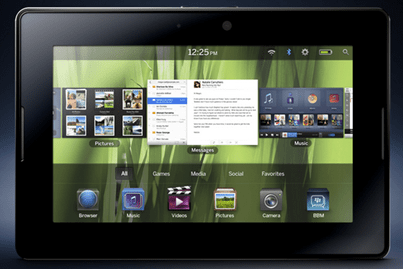Editor’s note: Guest author Jon Evans is a novelist, journalist, and software engineer.
Oh, Research In Motion. You never miss an opportunity to miss an opportunity.
RIM was born in my home town, at my alma mater, so it’s depressing watching their empire rot and crumble before the Android / iPhone onslaught. I had high hopes for their new tablet, a potential game-changer—but alas, they’ve hamstrung it before it’s even been released. Here’s what they should have done with it:
1) Embrace Android (phones)
RIM proudly announced that while their PlayBook can’t connect to cell networks, it can tether to a compatible BlackBerry via Bluetooth. They might as well have installed a “For BlackBerry Owners Only” startup screen. Way to pre-alienate most of the market, guys.
Instead they should have stressed that they can also connect via Wi-Fi to Android 2.2 phones, and announced an Android app that syncs data between Androids and PlayBooks. They can’t support the iPhone, Apple would never allow it, but Android’s wide open.
“But Android is the competition!” No, Android tablets are. Tablets and phones are entirely different entities. RIM’s tech people understand that: it’s why the PlayBook runs a brand-new OS built by QNX, a company they bought earlier this year, rather than a new iteration of the archaic BlackBerry OS. Which is no bad thing—QNX is well-regarded, and time-tested. (I fondly remember being reprimanded for hacking into my high school’s QNX system many years ago.)
Until RIM drops that millstone called the BlackBerry OS, or replaces it with a QNX-based version, Android and Apple will eat their phones for lunch. Meanwhile, they need to accept that the PlayBook should complement rather than compete with Android phones.
2) WebWorks or AIR: Pick One.
I’m an app developer. Pity me. I have to know Java, Eclipse, Objective-C, XCode, and both the Android and iOS SDKs. I could use a cross-compiler like PhoneGap, but they’re clunky and slow to implement new features. If Windows Phone 7 takes off, I need to master another language, environment, and platform—and while BlackBerry apps are written in Java, it’s an older version than Android’s, and the SDK is completely different.
I liked Palm, but I was delighted to see it die, and Nokia’s decay into irrelevance is a relief. Nothing against them; I just don’t want the hassle. App developers don’t want choice, we want consistency.
So what does RIM give us? Choice. First they offer free PlayBooks to developers who build PlayBook apps with Adobe’s AIR. Then they say you can build both PlayBook and BlackBerry 6 apps with BlackBerry WebWorks. Rather than split their development and support resources between two different platforms, they should have chosen one and ran with it. These “choices” will only confuse and irritate the app makers who will determine their fate.
3) Change the name. And the target market.
PlayBook? Really? You’re Research In Motion. You’re business, baby. Your tech level may be a little antiquated, but you’re secure, you get stuff done, and the new tablet brings you back up to speed. You should be targeting corporate videoconferencing and hospital patient data and business travelers. That’s why you’ve got BlackBerry tethering, right?
Instead you called it the PlayBook and can’t stop talking about how it runs Flash, both of which will make CIOs everywhere raise skeptical eyebrows. You’re trying to be all things to all users, including consumers—but Android tablets run Flash too, and they’ll be available for Christmas; the iPad boasts a bigger screen, superior apps, and the Apple halo; and worst of all, the PlayBook will probably launch right in the teeth of the iPad 2 hype machine. RIM should conquer the business-tablet space first. Instead, they already look like also-rans before they even have their running shoes on.
It’s a shame. I wish RIM well, and their new tablet looks like a potentially superb device. But they’re squandering that potential before it even has a chance to succeed.
